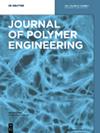Hydrogel for slow-release drug delivery in wound treatment
IF 1.7
4区 工程技术
Q4 POLYMER SCIENCE
引用次数: 0
Abstract
When skin comes into direct contact with the outside environment, it becomes extremely prone to injury and external factors can make wounds difficult to heal. Traditional medical dressings often cause secondary injury and are poorly resistant to infection. Hydrogels offer a promising alternative to overcome these difficulties. In this study, chitosan (CS)/gelatin (GEL)/polyvinyl alcohol (PVA) hydrogels were developed by chemical cross-linking and loaded with the drug kitasamycin (KM) for testing. The hydrogels’用于伤口治疗中缓释给药的水凝胶
当皮肤与外界环境直接接触时,极易受伤,外部因素也会导致伤口难以愈合。传统的医用敷料往往会造成二次伤害,而且抗感染能力差。水凝胶为克服这些困难提供了一种前景广阔的替代方案。本研究通过化学交联法开发了壳聚糖(CS)/明胶(GEL)/聚乙烯醇(PVA)水凝胶,并在其中添加了药物吉他霉素(KM)进行测试。对水凝胶的体外药物释放和伤口愈合性能进行了评估。水凝胶的体外药物释放持续了 48 小时,明显长于 KM 溶液的释放时间。抗菌活性测试表明,在与 KM 溶液浓度相同的情况下,负载的 KM 水凝胶仍能保持其抑菌能力,而且在体外抑菌过程中,KM 水凝胶的抑菌时间比 KM 溶液的抑菌时间明显延长。这证实了水凝胶的控释能力。此外,水凝胶还使小鼠的伤口面积缩小了 96%,组织病理学测试表明伤口完全重新上皮。制备的水凝胶成功证明了其控制药物释放和促进皮肤伤口愈合的潜在能力。
本文章由计算机程序翻译,如有差异,请以英文原文为准。
求助全文
约1分钟内获得全文
求助全文
来源期刊

Journal of Polymer Engineering
工程技术-高分子科学
CiteScore
3.20
自引率
5.00%
发文量
95
审稿时长
2.5 months
期刊介绍:
Journal of Polymer Engineering publishes reviews, original basic and applied research contributions as well as recent technological developments in polymer engineering. Polymer engineering is a strongly interdisciplinary field and papers published by the journal may span areas such as polymer physics, polymer processing and engineering of polymer-based materials and their applications. The editors and the publisher are committed to high quality standards and rapid handling of the peer review and publication processes.
 求助内容:
求助内容: 应助结果提醒方式:
应助结果提醒方式:


